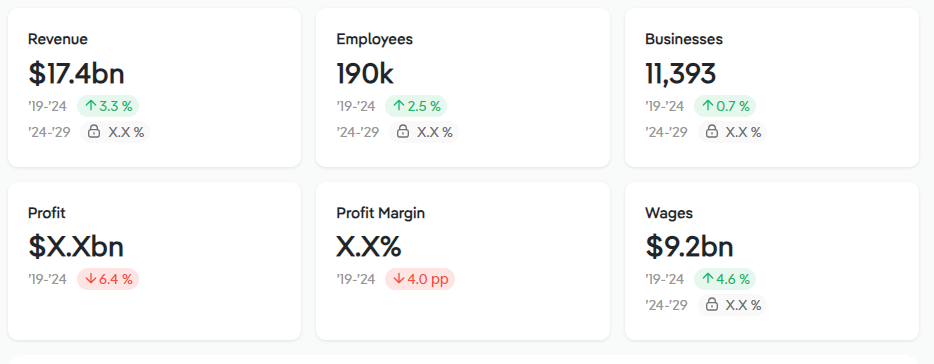Opening a childcare business can be an exciting, but daunting proposition.
As with anything, the answer to whether you should start a childcare centre in Australia comes back to your goals.
In this article, we’ll explore some of the key aspects to owning a child care business, including the regulatory environment, the business model, market demands and trends, and your revenue and expense structure if your primary goal is profitability.
Takeaways:
-
There are many different types of child care services, each catering to different needs and therefore with different revenue, expense and profitability models.
-
The market is growing and demand for services is strong. The market is also highly regulated so it’s important to understand the needed qualifications, approvals and compliance up front.
-
An important first step in starting a childcare business is getting a business plan and cash flow projections, as well as any funding needed to launch.

What are the types of early childhood businesses?
In Australia, early childhood services cater to the care, development, and education of children from birth to school age. These services play a crucial role in supporting children’s learning and wellbeing while also assisting parents in balancing work and family responsibilities.
Here are the main types of early childhood services available in Australia:

Long Day Care (LDC):
-
Long day care services operate for extended hours, typically from early morning until late afternoon or early evening, to accommodate working parents.
-
They offer full-day care and educational programs for children from birth to school age.
-
LDC services are licensed and regulated by government authorities to ensure compliance with national quality standards.
Family Day Care (FDC):
-
Family day care involves the provision of childcare in the homes of registered educators.
-
Educators care for small groups of children in a home environment, offering a more intimate and personalized setting.
-
FDC services cater to children from birth to school age and often provide flexible hours to accommodate parents’ work schedules.
Preschool/Kindergarten:
-
Preschools and kindergartens offer early education programs for children in the year or two before they start formal schooling.
-
These programs focus on preparing children for the transition to school by developing social, emotional, and cognitive skills through play-based learning activities.
-
Preschools and kindergartens may be standalone facilities, part of long day care centers, or operated by schools or community organisations.
Outside School Hours Care (OSHC):
-
Outside school hours care services cater to the care and supervision of school-aged children outside of regular school hours.
-
They operate before and after school, as well as during school holidays, to support working parents and provide a safe and stimulating environment for children.
-
OSHC programs offer a range of recreational and educational activities, including homework assistance, sports, arts and crafts, and social interaction with peers.
Occasional Care:
-
Occasional care services offer short-term, flexible childcare options for parents who need temporary care arrangements.
-
These services may operate on a casual or as-needed basis, providing care for children for a few hours or days at a time.
-
Occasional care can be particularly beneficial for parents with irregular work schedules, appointments, or other commitments.
Mobile and Outreach Services:
-
Mobile and outreach services deliver early childhood programs and support to families in remote or disadvantaged communities.
-
These services may include mobile playgroups, parenting support programs, health and nutrition initiatives, and early intervention services.
-
Mobile and outreach services play a vital role in addressing barriers to accessing early childhood education and care in underserved areas.
Each type offers different benefits and caters to different needs.

What is the National Quality Framework?
Both federal, state and territory governments are responsible for the health, safety and educational outcomes of Australian children. This comes together under the NQF.
If you are looking to open a business for the first time, it’s really important to understand the approval process in your state, and how you become an approved provider. That’s why it’s a good idea to work with professionals who understand the childcare service approval application process.
At Smart Business Plans we’ve helped more than 80 child care centre owners with business plans, cash flow projections, and business finance as part of the overall process of establishing an early childhood service. Book a meeting here if you’d like to see if what we do is a good fit for you.
How much does the average childcare centre make?
The childcare industry is highly decentralised, meaning competition is generally consider low. According to ibisworld, the industry has been recovering from the impacts of covid, and is seeing growth in revenue and participation.

Of course, how much revenue early childhood business could expect to make is highly dependent on factors such as location, demographics, and size of the facility amongst other things.
That said, gross profit margins of between 10% and 20% are commonly seen – for example if you could accommodate 50 children and assume occupancy of 90%, that would generate about $250,000 per annum. Then it’s just a case of working out your expenses, overheads and taxes to determine a profit margin.
The team at Smart Business Plans have helped launch more than 80 child care businesses – it’s always a good idea to talk to industry experts to help avoid mistakes.
Here is a calculator to help you get a working guide:
Child Care Centre Cost Calculator Australia
Estimate the costs of starting your child care centre in Australia. Enter your details below:
Estimated Costs
Initial Setup Cost: $0
Monthly Operational Cost: $0
Estimated First Year Total: $0
Estimated Capacity (based on 3.25 sqm per child): 0 children
Key things to know about starting childcare business
Opening a new early childhood education and care (ECEC) service is an exciting but complex process. Understanding the National Quality Framework (NQF) is essential for ensuring compliance and delivering high-quality care. Here’s a summary of the key points outlined in the ACECQA resource on opening a new service (getting provider approval):
-
Understanding the NQF: The NQF governs ECEC services in Australia, ensuring consistency and high standards. It consists of the Education and Care Services National Law and Regulations and includes the National Quality Standard (NQS) and assessment process.
-
Steps to Opening a New Service: The process involves thorough research and planning, applying for approval, preparing for assessment, undergoing assessment visits, receiving approval, and finally, opening and operating the service in compliance with regulations (Provider Approval).
-
Resources and Support: Regulatory authorities, such as ACECQA, provide guidance, support, and resources throughout the approval process. Professional networks and associations offer additional support and networking opportunities for new service providers.
By following the steps outlined in the NQF and leveraging available support networks, new service providers can get provider approval, ensure compliance, and deliver high-quality education and care to young children. You will also need to be familiar with the Child Care Subsidy (CCS) approval process.

Are childcare centres a good investment?
As with any investment, it’s important to understand risks as well as the potential rewards.
Growing Demand: With more parents joining the workforce and an increasing number of single-parent households, the demand for quality childcare services is on the rise. Investing in childcare allows you to tap into a consistently growing market with high demand.
Stable Revenue Streams: Childcare businesses often generate stable and predictable revenue streams. Parents prioritise childcare expenses, making them less susceptible to economic downturns. This stability provides a reliable source of income for your business.
Long-Term Investment: Investing in childcare is not just about immediate returns but also about building a long-term investment. As you establish your childcare business and build a reputation for quality care, you can benefit from steady growth and long-term profitability.
Positive Social Impact: Operating a childcare business allows you to make a positive impact on the lives of children and families in your community. Providing a safe and nurturing environment for children to learn and grow can be incredibly rewarding both personally and professionally.
Government Support: Governments often provide support and incentives for childcare providers, including subsidies, grants, and tax benefits. By taking advantage of these opportunities, you can reduce costs and enhance the financial viability of your childcare business.
Low Competition: While the demand for childcare services is high, the supply often falls short. This creates opportunities for new entrants to establish themselves in the market and differentiate their offerings. With strategic positioning and quality service delivery, you can stand out from the competition and attract clients.
Potential for Growth and Expansion: As your childcare business grows and establishes a strong reputation, you may have the opportunity to expand your services and reach. This could include opening additional locations, offering specialized programs, or diversifying into related services such as early childhood education.
Investing in childcare offers a unique combination of financial rewards, social impact, and personal fulfillment if working with children is something you enjoy. If you’re ready to embark on this rewarding journey, be sure to work with professionals who understand the process in Australia.
Developing your Child Care Business Plan
In Australia, launching childcare service will require establishing an extensive childcare business plan as part of the process of getting provider approval. The plan must outline the clear strategic direction of the organisation and contains operational strategies, financial forecasting and a comprehensive market analysis (the team at Smart Business Plans are experts at this).
Ideally the goal must be identified and strategically managed within the context of achieving competitive advantage. Innovative designs and sustainable solutions for children’s childcare centers and integrating educational programs into the curriculum are becoming more important. Understanding the financial landscape is crucial, requiring realistic financial forecasts.
How do I get started?
The team at Smart Business Plans would be happy to see if we are a good fit for what you are trying to achieve. You can talk to us about business planning, financial forecasting, or getting a business loan.
